
Types of Void Fill
Shop All Protective Packaging and Void Fill
Void Filler Functions
Understanding the role of void fill in your package is crucial before choosing the type of packaging fill for your shipping container. For example, shipping fragile items requires a different method of package filling than non-fragile items. Read on to learn more about the various functions protective packaging serves.
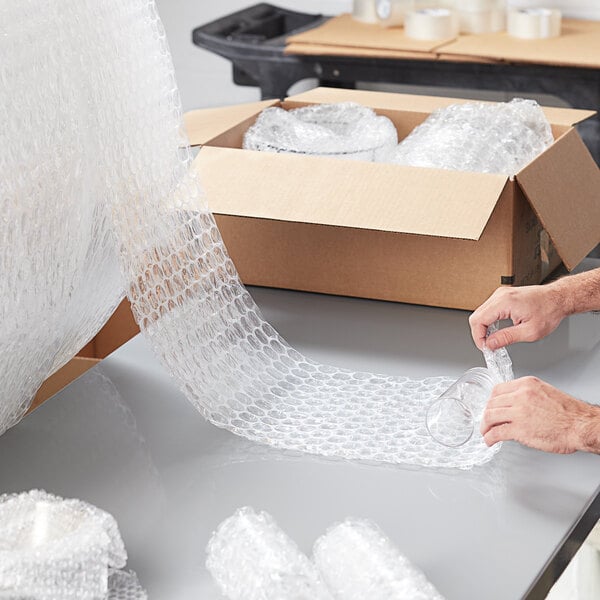
Wrapping
If you are shipping fragile items that could break or shatter easily, you will need to individually wrap them in void fill before placing them into the packaging. This method protects items from colliding with each other in the box and helps provide an extra layer of protection against external impact. Most fragile items will also need additional protective packaging to fill up the extra space in the shipping container. Some items that need individual protection include:
- Glassware
- China and dinnerware
- Ceramics
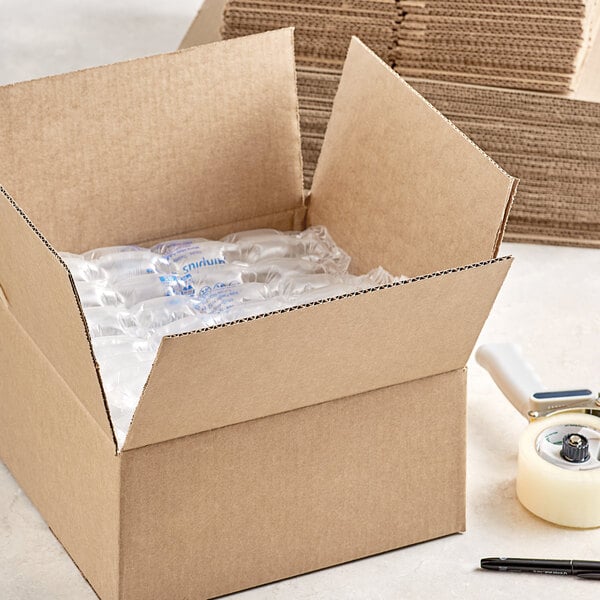
Blocking
The block and brace method uses protective packaging to fill the space in the shipping container to hold your items in place. This method goes beyond cushioning to completely immobilize the items during transit and provides shock absorption. It is best for fragile and heavy items. Some products that may need blocking include:
- Boxed items
- Multiple items in the same shipping container
- Items being shipped via multiple transit methods
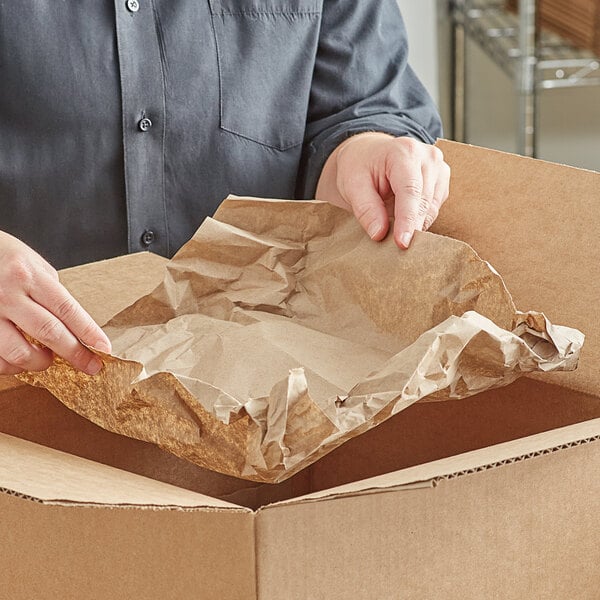
Cushioning
Also known as loose fill, using void fill for cushioning is best for non-fragile items. Loose fill materials eliminate extra space in shipping containers, provide edge crush protection, and cushion products from minor impacts in transit. Cushioning can also provide a soft layer of protection at the top or bottom of the shipping container. Cushioning void fillers can protect fragile items, but those products should be wrapped for further protection. Some items that need cushioning include:
- Books
- Ground and whole-bean coffee
- Boxed items
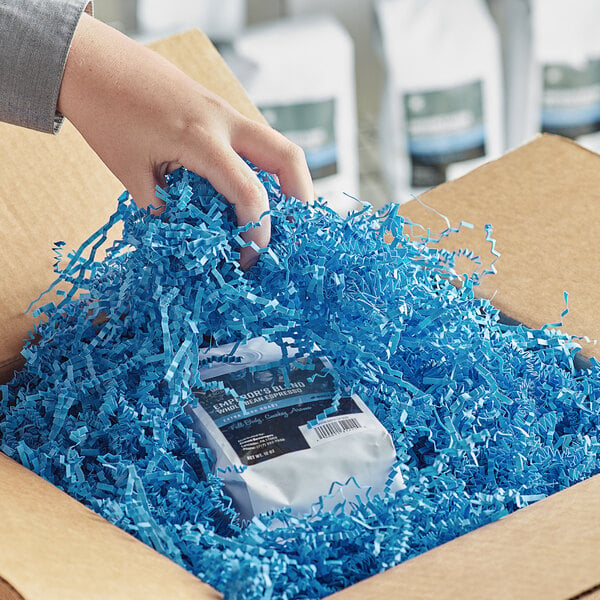
Presentation
Sometimes void fill is used to enhance a package's presentation and unboxing experience. Certain void fillers come in vibrant colors to make your items stand out, or they are customized to include your brand. You can use sustainable package fillers with your eco-friendly shipping container to further communicate your brand’s commitment to protecting the environment. Package presentation is especially important for small businesses that ship. Some products that may need an enhanced presentation include:
- Subscription boxes
- One-of-a-kind and custom products
- Luxury items
Package Fillers
There are four package filling material types: paper, foam, plastic in the form of bubbles, or molded fiber. Each material comes in various styles to perform different functions for filling the void space in your boxes.
1. Packing Paper
Packaging paper is denser and sturdier than standard writing paper to protect items during transit. Use packaging paper to fill space, protect individual products, and provide cushioning. Paper is one of the most frequently used void fillers because it's affordable, easy to purchase in bulk, and oftentimes can be recycled.
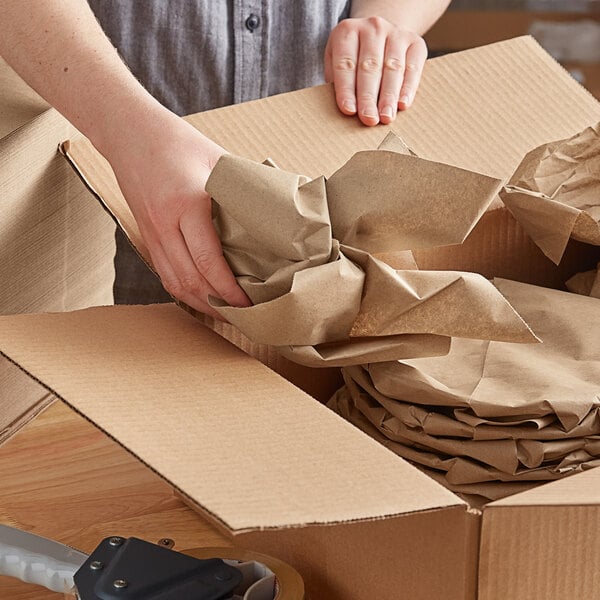
Kraft Paper
Versatile in application, kraft paper is a low-cost, all-purpose packaging material. When choosing the best kraft paper for your needs, check the product's basis weight, which is usually notated with a number and a "#" sign after it. The higher the basis weight, the heavier the paper. Thinner, more pliable kraft paper is a good option for cushioning applications whereas thicker, stiffer kraft paper is best for wrapping fragile items.
- Eco-friendly alternative to plastic void fill
- Ideal for protecting fragile and non-fragile items
- Affordable and available in bulk
- Recyclable and non-toxic
- Best for: Wrapping, blocking, and cushioning
- Comes in: Rolls and fan folds

Crinkle Paper
Typically made from recycled kraft paper, crinkle paper is a protective loose-fill packing material that also lends itself to brand enhancement. It is used to fill boxes and provide basic cushioning for non-fragile items. Crinkle paper's accordion-style design compresses easily to fit more into packaging, which further protects your items. It also makes for a great presentation and comes in many different colors. Use kraft-colored shredded paper to give your packages a rustic, down-to-earth feel, or use colored crinkle paper to color-coordinate with your brand.
- Eco-friendly alternative to plastic void fill
- Ideal for cushioning non-fragile items
- Available in bulk
- Recyclable and non-toxic
- Available in a variety of colors
- Best for: Cushioning and presentation

Tissue Paper
Tissue paper is a great wrapping solution to protect items from dust and minor scuffs while providing a beautiful presentation. Use tissue paper to wrap items that could benefit from dust protection like clothing, shoes, and plastic or melamine dinnerware, or as a base layer in conjunction with kraft paper to wrap delicate items, such as jewelry, glass, candles, and soaps that can easily scuff. Oftentimes, tissue paper can be customized to include your branding, making it great for adding on top of items to enhance your customer's unboxing experience.
- Enhances packaging presentation and brand awareness
- Provides dust and minor scuff protection
- Available in a variety of sizes and colors
- Best for: Presentation, wrapping
2. Plastic Packaging
Plastic packaging comes in the form of bubble bags, bubble rolls, or air pillows. It is lightweight, affordable, and effective in void fill and protecting individual items during shipping. There is even bubble packaging that meets standard UPS shipping guidelines to ship via ground.

Bubble Packaging
Flexible enough to easily fit around oddly-shaped items, bubble packaging is an effective solution for wrapping fragile items. Bubble packaging comes in the form of bubble rolls or bubble bags and features continuous, durable air-filled sacs that cushion and protect products. They are moldable and great for wrapping delicate and unique-sized items. Rolls come in perforated and non-perforated options for fixed or customizable sheet lengths, and bubble bags feature self-sealing closures to eliminate the need for additional tape. When deciding which size of bubble packaging you need, look at the diameter and thickness of the bubble. In general, the larger and thicker the bubble size, the more impact protection an item has.
- Ideal for protecting fragile items in transit
- Flexible and moldable design
- Best for: Wrapping
- Comes in: Rolls and bags
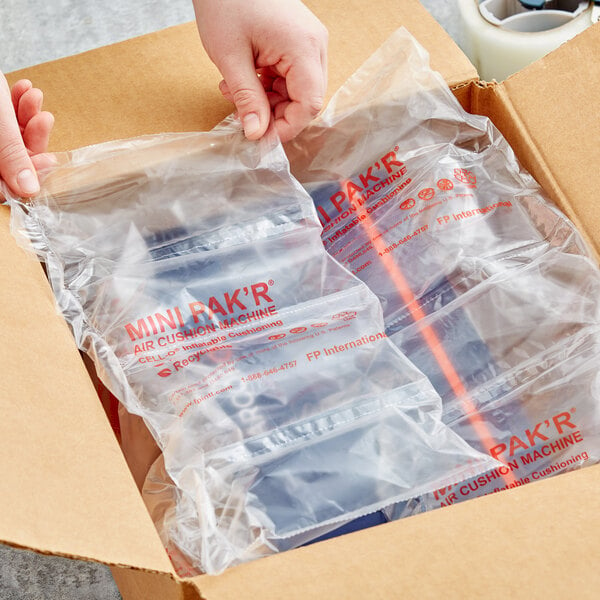
Air Pillows
Using air pillows allows you to fill excess space in your shipping box with minimal material. In addition to void fill, they are great for blocking items to protect them from shifting during transit. Air pillows come flat and uninflated for storage and must be used with a compatible air pillow machine to inflate. Due to the high upfront cost of the machine, air pillows are better suited for businesses and warehouses that frequently ship products.
- Provide void fill and prevent shifting
- Lightweight to keep shipping costs down
- Must be inflated with a compatible air pillow machine
- Many are recyclable
- Best For: Cushioning and blocking
3. Packaging Foam
Shipping foam is a versatile, lightweight, and affordable packaging material. Foam packaging comes as either polyurethane or polyethylene, each having different levels of thickness and sizes to accommodate your cushioning, blocking, and wrapping needs. Despite its versatility and effectiveness, many businesses are trying to phase out their usage of the material as Styrofoam bans are enacted in certain states.
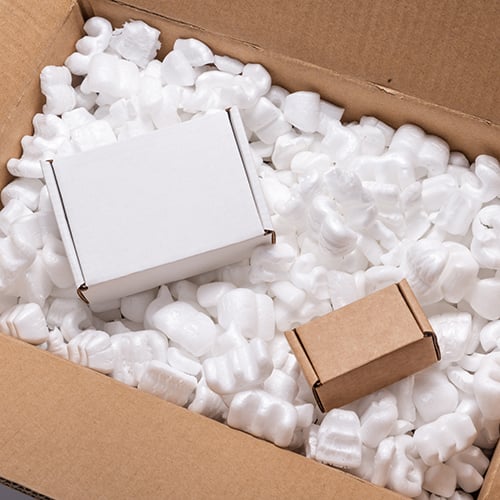
Packing Peanuts
Primarily used for cushioning, packaging peanuts are made from expanded polystyrene and are added loose to packaging to fill in the excess space and protect the items inside. Compared to crinkle paper, peanuts conform better to the packed item. They interlock within the package to fill the gaps of space and provide effective padding while in transit without contributing too much to the package's overall weight. However, they are not environmentally friendly nor do they provide a good unboxing experience. Peanuts can be a hassle for recipients to clean up and they are usually not recyclable.
- Ideal for filling excess space in a shipping container
- Conforms to packed items for effective protection
- Lightweight to keep shipping costs down
- Available in a variety of colors
- Best for: Cushioning
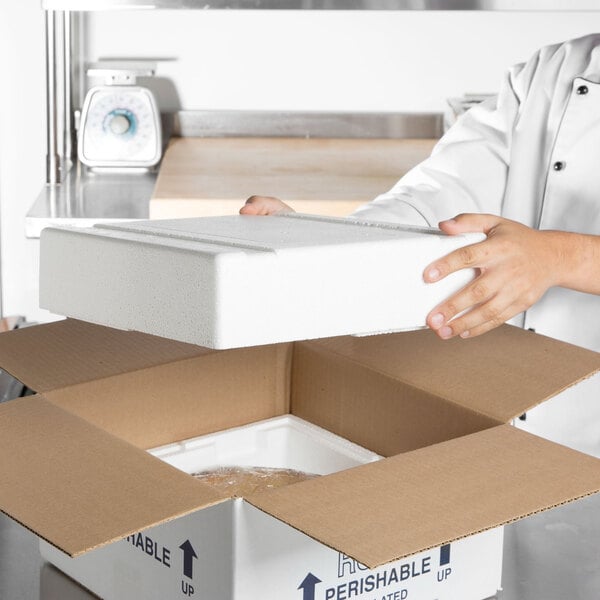
Foam Packing Blocks
Also called foam cushions, foam packing blocks encase items to tightly secure them during transit. They are denser than foam rolls and packaging peanuts, making them especially useful for blocking and bracing as well as edge crush protection. They can also be cut into any size and shape for greater packing versatility. Some foam shippers have insulating properties to ship and preserve temperature-sensitive foods.
- Dense construction is ideal for preventing items from shifting in transit
- Keeps package contents safe from shock and surface damage
- Also provides edge crush protection for fragile items
- Best for: Blocking and cushioning
- Comes in: Blocks, sheets, and cartons
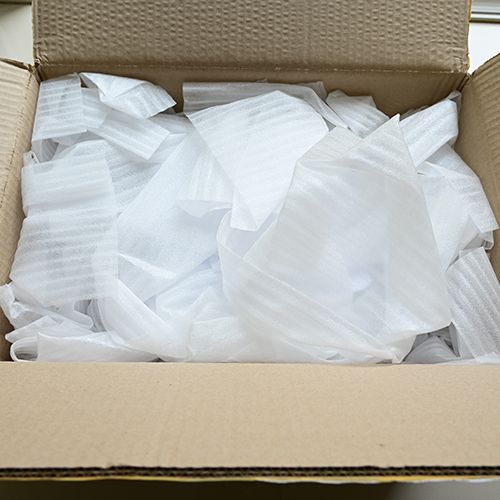
Foam Rolls
Coming in perforated and non-perforated options for fixed or customizable sheet lengths, foam rolls are lightweight, non-abrasive sheets of foam that protect fragile items, such as dinnerware, pictures, and art, from scratches and shock. Many foam rolls are also anti-static, which is typically denoted by the roll's pink color. Anti-static packaging foam is ideal for packaging electronics to dissipate any electrostatic charges.
- Lightweight
- Shock-absorbing
- Affordable
- Comes in various thicknesses and lengths
- Best for: Wrapping and cushioning
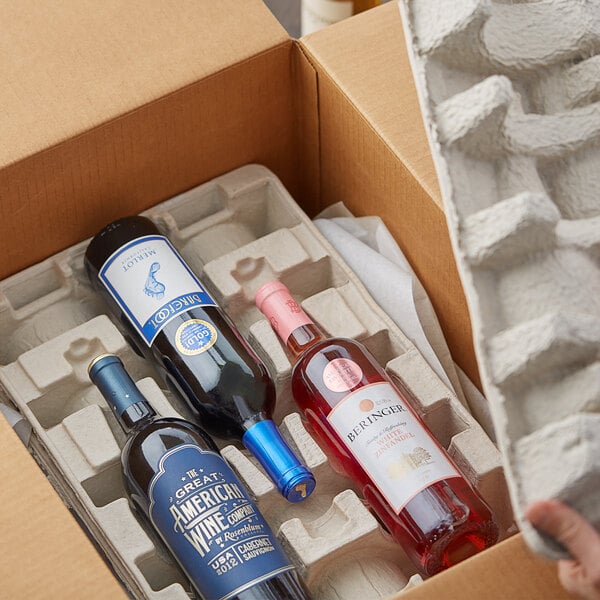
4. Molded Fiber Packaging
Predominately used for wine, spirits, and other beverage shipping, molded fiber packaging keeps the bottles secure in a horizontal position during transit. The shipper trays are stackable to fit multiple trays per shipment while maintaining reliable protection of fragile items. Molded pulp fiber has a durable, rigid construction and is made from a variety of recycled raw materials, such as paper or cardboard. Because it is made from recycled content and renewable resources, it is an eco-friendly alternative to foam packaging.
- Durable, rigid construction protects items from shifting in transit
- Eco-friendly and recyclable
- Typically do not contain chemical additives, coatings, or dyes
- Affordable
- Best for: Blocking and cushioning
Related Resources

Selling Food Online
As the internet continues to evolve, foodservice businesses are innovating off-premise dining dining solutions and finding new ways to sell products. Through e-commerce, it's possible to interact and complete transactions with customers around the world. However, for many prospective business owners, the practice of selling food online may be a new concept. If you're interested in selling food online, continue reading to learn how to do so in a safe, successful, and legal manner. Click any of the sections below to learn how to start and manage your own online food selling business: How to Sell Food Online How to Ship Food Food Labeling Requirements How to Market a Food Product Online How to Sell Food Online Though it may seem simple, there
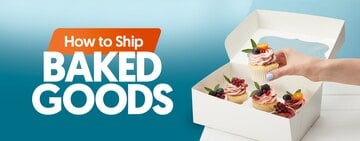
How to Ship Baked Goods
If you develop a reliable shipping strategy, selling baked goods online can broaden your customer base or allow you to forgo a storefront. Mailing delicate, perishable pastries requires extreme care. Whichever type of bakery you operate, use our bakery shipping guide to ensure your customers receive fresh, safe-to-consume, and intact baked goods. Click below to dive into the bakery shipping information that interests you: How to Ship Cookies Bakery Shipping Strategy How to Ship Macarons How to Ship Bread How to Ship Banana Bread How to Ship Cake How to Ship Cupcakes How to Ship Pie How to Ship Brownies Bakery Shipping FAQ How to Ship Cookies How to Ship Cookies without Breaking Given their hearty nature, cookies are one of the best baked go
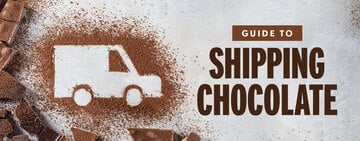
How to Ship Chocolate
In this interconnected environment, shipping chocolate straight to your customers anywhere in the country is vital to your success. However, chocolate's temperature sensitivity presents many challenges, especially when mailing it across long distances. Whether you have a booming e-commerce business or you're mailing food for the first time, use our chocolate shipping guide to deliver your products to customers. Shop All Mailing, Shipping, & Packing Supplies Use the following links to learn how to ship different chocolate candies: How to Pack Chocolate for Shipping How to Ship Chocolate without Melting Best Way to Ship Chocolate How to Ship Chocolate Covered Strawberries How to Ship Chocolate Covered Pretzels How to Ship a Breakable Chocolat
- Topics 1346
- Industrial 55
- Troubleshooting Guides 21
- Restaurant Management 128
- Bar Management 55
- Catering Tips 35
- Bakery Management 42
- Food Trucks & Concessions 49
- Advertising & Marketing 37
- Eco-Friendly Tips 11
- Facility Layout & Design 41
- Coffee Shop Tips 28
- Installation & Maintenance 51
- Janitorial & Pest Control 30
- Safety & Sanitation 88
- Startup Tips 104
- Menu Design 10
- Kitchen & Cooking Tips 81
- Hospitality Management 23
- Pizza & Sandwich Shop Tips 36
- Smallwares 37
- Food Prep 88
- Tabletop Items 17
- Disposables 22
- Calculators & Tools 6
- Consumables 52
- Warewashing & Laundry 18
- Cooking Equipment 90
- Food Storage & Refrigeration 51
- Beverage Equipment 34
- Office Supplies 6
- Resource Type
- In-Depth Articles272
- Buying Guides296
- How-Tos93
- Product Reviews77


